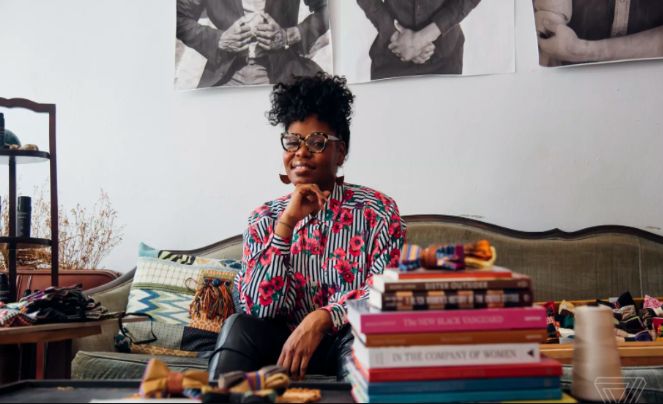Nisha Blackwell remembers wearing a lot of hand-me-down clothes as a kid and sorting through things to try on with her mother and grandmother.
Thrifting was just a thing everyone did, long before it was rebranded as upcycling, she says.
“The idea of thrifting is embedded with who I am as a person,” Blackwell says. “When you have to wear something someone else already wore, you have to learn to be resourceful to be fashionable.”
Using every bit of available fabric became the foundation of Knotzland, the bespoke bow tie company Blackwell founded in Pittsburgh in 2014.
It gave her the chance to marry her experience with upcycling thrifted clothes and other discarded materials to her interest in protecting the environment.
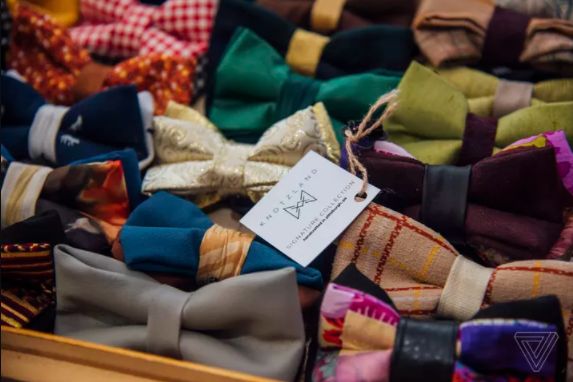
The process of upcycling takes an item like a piece of clothing or an old piece of furniture and turns it into something new, usually giving it a new function and a second life.
It’s not the same as recycling, which applies a process to break the item down into its raw materials for reuse in another product.
An upcycled item has its original material, just presented or remade into a new final form. It’s a natural process for clothing and other textiles.
Upcycling also helps offset some less environmentally-friendly manufacturing processes, from the energy and water used in production to the air pollution caused by transporting goods to stores.
And while it has grown in popularity over the past decade, as Blackwell notes, the roots of upcycling lie in much older traditions.
“That helps us just really enhance the life cycle of these materials, and then we’re actually disrupting them from entering landfills,” Blackwell says.
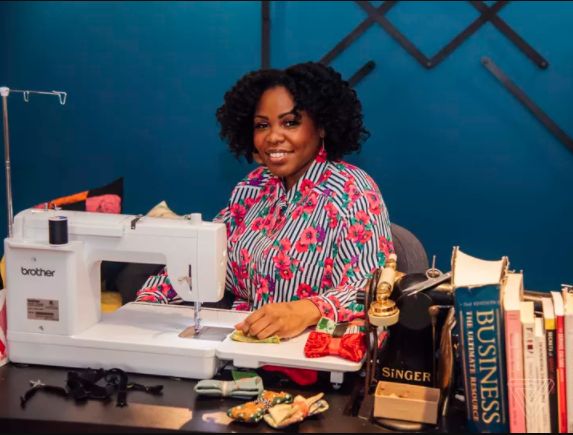
In 2018 alone, US landfills received 11.3 million tons of textile waste, according to the Environmental Protection Agency.
Blackwell notes that a lot of materials used in clothing —particularly in so-called fast-fashion lines — are synthetics like polyester, which are plastic-based.
So keeping these materials out of landfills is significant for the larger environment.
“Within the circular economy, you focus on continuing to design and redesign, and design for the life beyond the initial consumer. We’re creating things of quality that people can hand down and pass down to the next generation,” she says.
A lot of the first year of Knotzland was about educating people about why she felt it was important to reuse materials, Blackwell says.
“I knew I wanted to use reclaimed material. I wanted to be part of the solution to reduce textile waste,” she says. “I would go to fashion meetups in Pittsburgh, and things like Pittsburgh Earth Day, and it was like all these things were meshing for me.”
Many of Knotzland’s customers weren’t aware of the life cycle of a piece of clothing, and that their bow ties are more than just a piece of restyled cloth.
“We serve as an entry conversation about sustainability,” she says, “so now the customer can go out into the world and speak about it. Now we have these little pieces of information in the world and our customers are excited about it because it’s a product that is expressive and true and unique to them and good for the environment.”
Knotzland sources material from upholstery companies, drape makers, and other thrift shops.
Blackwell says these can be deadstock, discontinued products, or last year’s fashions that are still like-new fabrics, but just aren’t usable by a manufacturer or textile supplier.
And as a board member of the Pittsburgh Center for Creative Reuse (PCCR) — which bills itself as a nontraditional art supply shop where people can donate and shop for used art and craft supplies — she had access to its wide collection of reusable materials that one might not find at other thrift shops.
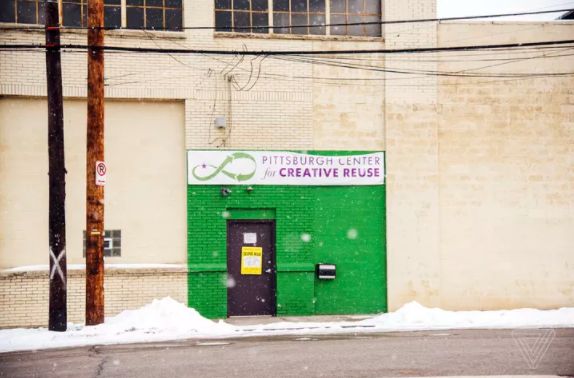
“We take discards and other donations that might be difficult to donate to a regular thrift store,” says PCCR executive director Ash Andrews.
“Someone might have a half-used tube of paint. A lot of those kinds of things might get thrown away because you can’t really donate them.”
And while upcycling in fashion started with thrifters and indie designers, it’s also being recognized by larger mainstream brands as a way to reduce waste in the industry.
For instance, women’s clothing brand Eileen Fisher’s Renew program buys back clothing from customers and resells it for a second life.
Garments that can’t be resold as-is are upcycled into artwork, pillows, and wall hangings for a third life.
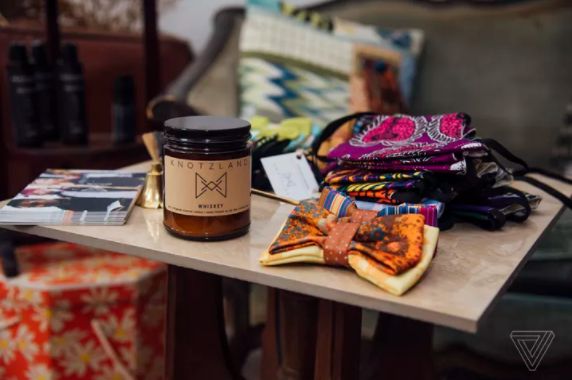
Blackwell estimates that Knotzland has “rescued” more than 3,000 pounds of textile waste to date.
She’s also proud that Knotzland created work-from-home jobs for the seamstresses who make the bow ties, long before the pandemic struck, which helped the company weather the uncertainty of the past year.
Instead of the focus on weddings she was planning in 2020, Knotzland instead pivoted to making masks.
The process reminded Blackwell why she was determined to scale Knotzland ethically, not just quickly.
“This is slow fashion,” she says, “which is much better for the environment.”
Andrews says a company like Knotzland is a uniquely Pittsburgh kind of company.
“In a postindustrial town like Pittsburgh, reuse is just part of how we do things,” they said, pointing to old steel mills that have been repurposed into things like manufacturing hubs and shopping plazas, and the Carrie Furnace, a former US Steel blast furnace-turned-museum on the Monongahela River.
“Pittsburgh’s been through a lot of hard times, but it’s sort of that mindset of ‘use it up, make do, or do without.’ Especially among folks who don’t have a lot of resources, it’s just the way we grew up,” Andrews said.
“Like you can wash off that plastic bag and use it again.”
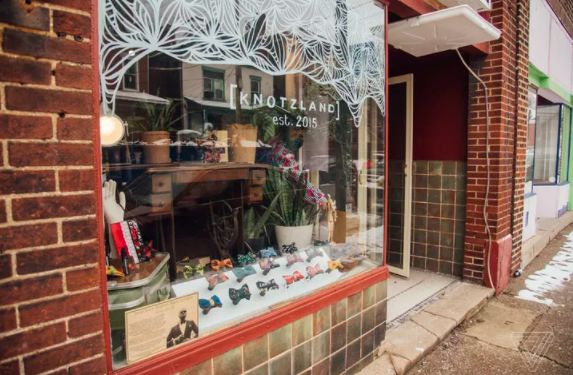
Blackwell says having a fashion company located in Pittsburgh rather than a bigger city like Los Angeles has come with its downsides.
“I go to the West Coast and talk about what we do, and it feels like second nature to them, they’re more far along in their sustainability journey,” she says, with concepts like upcycling and environmental concerns about food much more ingrained into everyday practices.
The “convincing” conversations didn’t take as long, she says.
“But in return, I do think Pittsburgh has allowed us to become more well-rounded at our own pace.”
Blackwell adds that she grew up in a community that was disinvested in, making her always feel like the underdog who had to work a little bit harder.
“Being a Black woman in sustainability, a Black woman in a menswear company, acceptance took a while. ‘Is she going to keep making bow ties?’ But people realized this wasn’t just a hobby, that we were really committed to doing good for the community and for the environment.”
Latest Stories
-
Real Madrid beat Sevilla to keep pressure on leaders Atletico
44 minutes -
Liverpool put six past Spurs to go four points clear
46 minutes -
Manchester United lose 3-0 at home to Bournemouth yet again
49 minutes -
CHAN 2024Q: ‘It’s still an open game’ – Didi on Ghana’s draw with Nigeria
57 minutes -
CHAN 2024Q: Ghana’s Black Galaxies held by Nigeria in first-leg tie
2 hours -
Dr Nduom hopeful defunct GN bank will be restored under Mahama administration
2 hours -
Bridget Bonnie celebrates NDC Victory, champions hope for women and youth
3 hours -
Shamima Muslim urges youth to lead Ghana’s renewal at 18Plus4NDC anniversary
4 hours -
Akufo-Addo condemns post-election violence, blames NDC
4 hours -
DAMC, Free Food Company, to distribute 10,000 packs of food to street kids
5 hours -
Kwame Boafo Akuffo: Court ruling on re-collation flawed
5 hours -
Samuel Yaw Adusei: The strategist behind NDC’s electoral security in Ashanti region
5 hours -
I’m confident posterity will judge my performance well – Akufo-Addo
6 hours -
Syria’s minorities seek security as country charts new future
6 hours -
Prof. Nana Aba Appiah Amfo re-appointed as Vice-Chancellor of the University of Ghana
6 hours

